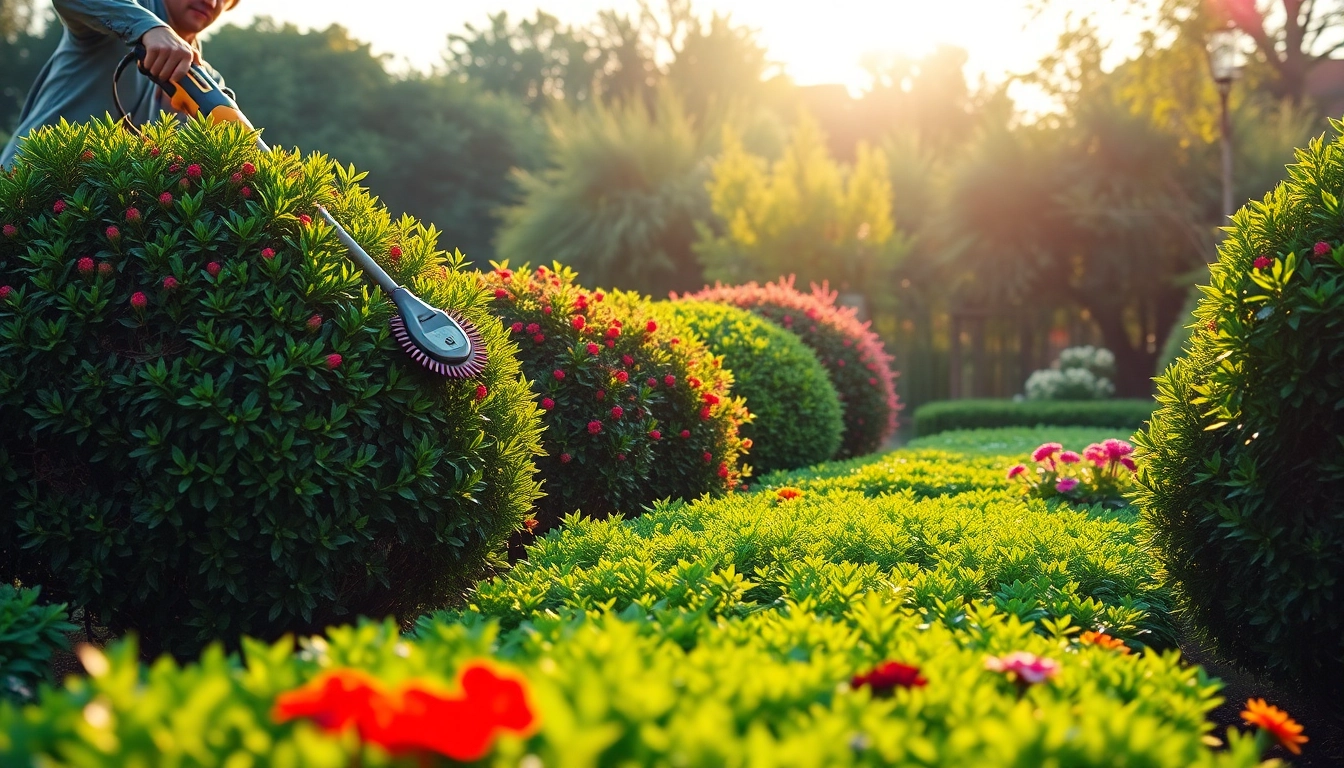Understanding Shrub Trimming Basics
What is Shrub Trimming?
Shrub trimming, often referred to as pruning, is the horticultural practice of cutting back shrubs to promote healthy growth and maintain desired aesthetics. This process involves selectively cutting branches and stems at specific points to enhance the plant’s structure and remove any dead or diseased parts. Essential for both the health of the shrub and the beauty of the landscape, shrub trimming is an art that balances moderation and technique.
Benefits of Regular Shrub Trimming
Engaging in regular shrub trimming provides numerous benefits:
- Health Improvement: Regular trimming removes unhealthy or dead branches, thereby preventing the spread of disease and promoting vibrant growth.
- Enhanced Aesthetic Appeal: Well-trimmed shrubs contribute to a polished and manicured landscape, increasing visual appeal.
- Controlled Growth: Trimming helps maintain a shrub’s size, preventing it from overgrowing its intended space while ensuring it remains within boundaries.
- Increased Airflow: Thinning out dense growth opens up the shrub, allowing for better air circulation and sunlight penetration.
Essential Tools for Shrub Trimming
Equipping yourself with the right tools is vital for effective shrub trimming. Here are some essential implements:
- Hand Pruners: Ideal for small branches, hand pruners provide precision and control.
- Hedge Shears: Best suited for shaping and trimming larger shrubs, hedge shears can handle broader cuts.
- Loppers: These are essential for pruning larger branches that are beyond the reach of your hands.
- Pruning Saw: For very thick branches, a pruning saw offers the needed strength and reach.
- Protective Gear: Safety glasses and gloves are important to protect yourself from debris and sharp edges.
Best Practices for Shrub Trimming
When is the Best Time for Shrub Trimming?
The timing of your shrub trimming is crucial for efficacy. Generally, late winter or early spring is considered ideal for most shrubs, as this promotes strong new growth once the weather warms. However, timing can vary significantly based on the type of shrub:
- Spring-blooming Shrubs: Trim these immediately after flowering for optimal results.
- Summer-blooming Shrubs: Trim these in late winter or early spring before new growth begins.
- Evergreen Shrubs: Prune these lightly in early spring to maintain shape.
Following the 1/3 Rule in Shrub Trimming
The 1/3 rule in shrub trimming indicates that no more than one-third of a shrub’s foliage should be removed at any one time. This guideline helps to maintain the plant’s health and prevents stress after heavy pruning.
By adhering to this rule, you allow for adequate foliage to remain, helping the shrub recover quickly and continue healthy growth. Over-pruning can lead to issues such as weak growth, increased susceptibility to disease, and an overall reduction in the shrub’s health.
How to Identify When to Trim
Understanding the right signs that indicate a shrub needs trimming is essential for maintaining its health:
- Dead or Diseased Branches: Any dead wood or branches infected by disease should be removed immediately.
- Overcrowding: Branching that is too dense can create a messy appearance and inhibit airflow.
- Shape Issues: If the shrub loses its defined shape or starts to look unkempt, it’s time to trim.
- Pests: An infestation can weaken the shrub, requiring attention to remove affected areas.
Common Shrub Trimming Techniques
Thinning and Shaping Shrubs
Two primary techniques are crucial for effective shrub trimming—thinning and shaping. Thinning involves selectively cutting branches back to the point of origin or lateral growth that allows light and air to penetrate the plant’s bushy portions. Shaping entails adjusting a shrub’s size and aesthetic form.
For optimal results, these techniques can be combined. Start by thinning out unneeded or weak stems, achieving a more robust shrub, and then follow through with shaping to ensure an attractive appearance.
Corrective Shrub Trimming
Corrective trimming is employed when bushes have been neglected or have sustained damage. This type of trimming involves:
- Removal of major overgrowth that hinders healthy growth.
- Cutting back problematic branches to encourage a more balanced shrub structure.
- Applying the rejuvenation method, which involves cutting older plants back to about one-third of their height to promote new growth.
Seasonal Trimming Strategies
Seasonal trimming strategies vary based on the growth cycle of the shrub. A comprehensive seasonal plan can include:
- Spring: Removal of dead or damaged branches and preliminary trimming to promote lush growth.
- Summer: Further shaping can be done to maintain aesthetics after spring growth.
- Fall: Minor trims to prepare for winter dormancy, focusing on any health issues to ensure robustness going into winter.
Special Considerations for Different Shrub Types
Deciduous vs. Evergreen Shrubs
Understanding the differences between deciduous and evergreen shrubs is crucial for effective trimming. Deciduous shrubs shed their leaves annually, making them typically more forgiving when it comes to timing for pruning. Evergreen shrubs, on the other hand, retain their leaves and require more precise timing to avoid disrupting their growth patterns.
While both types benefit from annual maintenance, decisions around when and how much to prune should be tailored accordingly. For example, evergreen shrubs benefit from light trimming in spring, whereas deciduous varieties can handle heavier pruning during their dormant season.
Flowering Shrubs: Timing Your Cuts
Flowering shrubs demand special attention when it comes to pruning. The timing of your cuts can greatly influence their flowering schedule.
- Spring-blooming shrubs: Cut these back right after they bloom to avoid removing potential blossoms for the next season.
- Summer-blooming shrubs: Prune these in late winter or early spring as they typically flower on new growth.
Native Shrubs and Their Unique Needs
Native shrubs often have specific growth patterns and adaptations to their environment. Therefore, their trimming requirements may deviate from non-native varieties. For instance, many native shrubs are more resilient to local pest pressures and are adapted to local climates, meaning they often require less invasive care.
It’s essential to research the specific requirements of your local species and consult with local gardening experts to appropriately address trimming needs while promoting native biodiversity.
Hiring Professionals for Shrub Trimming Services
When to Consider Professional Help
While many homeowners can tackle shrub trimming themselves, certain situations may warrant professional assistance. These can include:
- Large or overgrown shrubs that might be difficult to manage alone.
- When difficulty arises in accessing certain parts of the shrub or if specialized equipment is needed.
- If there’s uncertainty about health issues affecting the shrubs that require expert diagnosis.
- When safety is a concern, especially when using power tools or working near electrical lines.
How to Choose a Shrub Trimming Service
Choosing the right shrub trimming service can make all the difference in the health and appearance of your landscape. When selecting a professional service, consider the following:
- Experience: Look for companies with a proven track record in shrub trimming and care.
- References: Ask for and check references to gauge the quality of their work.
- Insurance: Ensure that the company has current insurance to protect you and your property.
- Certifications: Qualified professionals often hold certifications from landscaping or horticulture organizations.
Estimating Costs for Professional Shrub Trimming
Understanding the cost associated with professional shrub trimming services can help you budget effectively. On average, homeowners across the U.S. spend around $110 to $440, depending on the size and complexity of the shrubs being trimmed. Several factors can influence pricing:
- Size and type of shrub.
- Difficulty in accessibility and labor required.
- Additional cleanup costs for debris disposal.
- Frequency of service (single vs. recurring engagements).



